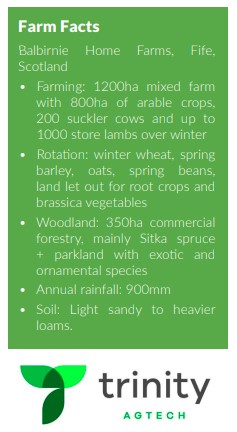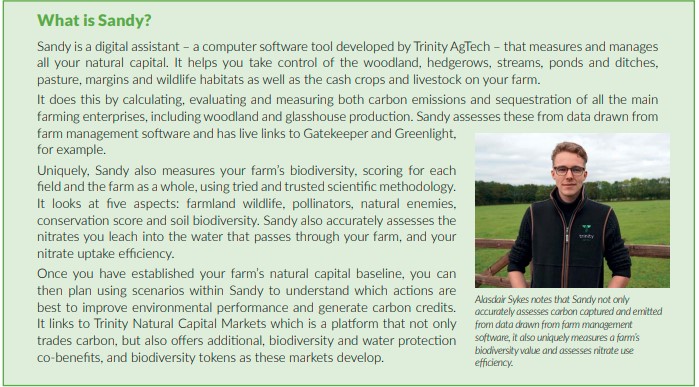Written by Tom Allen-Stevens
Balbirnie Home Farms in Fife, Scotland, has been on a regenerative agriculture journey, testing aspects of this within its role as an AHDB Strategic Cereal Farm. A tour of the estate highlights its natural capital assets, helping to determine its carbon baseline and the opportunities to develop.
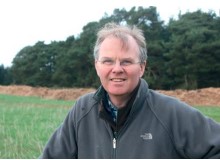
Standing at the edge of the 20ha field, you can see how the electric fencing has divided it into ‘paddocks’. David Aglen explains that the sheep are rotated around – never kept too long on each individual paddock, so that the field is ‘mob-grazed’. It seems a sensible way forward for temporary grass. “Oh no, this isn’t temporary grass, this is winter wheat,” remarks David. “I’m hoping these lambs will ensure we won’t have to apply a T1 fungicide or growth regulator, and also give the crop its early season nutrition and a fertility boost.”
Suddenly the pale green of the closest paddock takes on an entirely different complexion. It’s early March on Balbirnie Home Farms, just north of Glenrothes in Fife, Scotland. The lambs have recently been moved to the next-door paddock, and your instinct is to worry whether the remains of the winter wheat they left behind will ever recover. A closer inspection reveals fresh, green shoots are already coming through. The crop has lost most of its above-ground winter biomass, but this has passed through the sheep and been deposited back on the light, loam soils that lie just over 100m above sea level. It’s a practice that meets the regenerative agriculture system the farm has taken on, although David admits he’s not sure yet of the final effect on yield, nor whether the area was grazed for the optimum time.
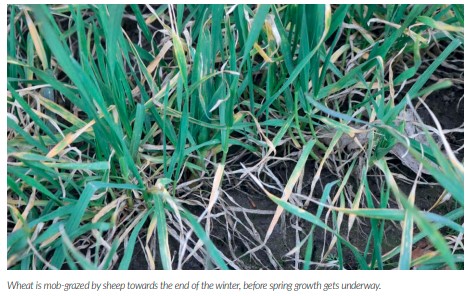
Moving to the largely untouched paddock next door, he points out the lower leaves, carrying a fair amount of disease. “These were never going to contribute very much to yield, and would just be an extra cost in terms of the fungicide we’d have to apply,” he says. “What I’m interested to know, though, is the effect on the bottom line and not just financially. We’re keen to assess our carbon footprint – we want to work out our baseline and also the farm’s biodiversity score. Then we want to look at the effect of the practices we’re implementing, whether they help to capture carbon or lose it, and just how much we can sequester.”

Balbirnie Farms has come on board with Sandy. This is software from Trinity AgTech that accurately assesses the carbon footprint, biodiversity and water quality of whole farm and all its enterprises on a field-by-field, cropby-crop basis (see panel). “It’s not just about the 800ha of arable cropping we have,” explains David. “We have 300ha in permanent pasture or temporary grass for our 200-head herd of suckler cows. There are also forage and cover crops, land let out for root and vegetable crops and 350ha of commercial forestry.”
Heading back into the estate, you pass parts of this woodland that have been left badly damaged by Storm Arwen. Owned by the Balfour family since 1642, the tree planting on the estate has been nurtured by many past generations who have developed its diversity and value, with some much-prized ornamental and exotic specimens. Today, two thirds of the commercial woodland is Sitka spruce, while the remainder consists mainly of Scots pine, larch and various deciduous species.

“From a farming and estate management perspective, we curse the trees royally, but now we’re beginning to understand their value. Certainly as far as carbon is concerned they could prove to be a real asset,” notes David. There’s also hedgerow that’s periodically coppiced, and another 6.5km has been recently planted. Past the block of trees, David stops briefly by a field of carrots, sitting under a thick mat of straw. “We’ve progressively reduced cultivations and now everything is direct drilled, except of course for the root crops. So we want to know how much of the carbon we’ve captured is released by the plough.”
In the next field is the youngstock of the suckler beef herd, kept outside all winter. The farm moved away from an intensive dairy unit installed in the 1970s into all arable. Now livestock has been re-introduced, again as part of the move to a regenerative system. “These animals will never see a shed, and I believe it’s better for them and for the soil that they graze outside all year round. But I’m interested in what that does for our emissions,” he says. Manure plays an important role on the farm and David gestures to a heap on the way back to the farm buildings. He explains that it’s regularly turned which composts it down, resulting in a lower volume of more nutrient-dense material that’s spread.
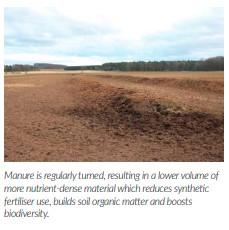
In the same field there are cover crops, and here he stops and pulls a spade from the pickup to inspect the soil that lies beneath. There’s no shortage of worms in the fresh earth that’s eased up, revealing a matted turf of roots. Cover crops form a major element of the arable system at Balbirnie Farms. David aims to retain green soil cover all year round, choosing vigorous, large-seeded species that establish quickly. “We feed cover crops to the livestock, drill through them in the spring and leave them as a mulch,” he explains.
“We had one crop that we took through to the summer and it yielded over 90t/ha of biomass, according to the measurements we took. What I want to know now is where all the carbon goes.” The farm has recently become an AHDB Strategic Farm and the cover crops form an important part of a programme of farm trials. These are run and monitored by SRUC, funded as part of AHDB’s Farm Excellence programme.
Back at the farm buildings, David parks up next to the hulking carcass of a large straw-burning boiler. “It used to dry the grain, and when we removed it and installed a kerosene burner, I finally got my life back. Removing it may be a backwards step in terms of our carbon footprint, but it was an almighty pain to run, and I’ve never once regretted the decision,” he says. As the farm tour concludes, he leaves the best until last – there in the shed is a 6m Horizon DSX 60-20 direct drill that’s barely touched the soil since it arrived on farm recently. It lies curled up next to the farm’s newly acquired second-hand 6m Väderstad Rapid. “We used to have a 4m John Deere 750A, but it was too small and we ran it too hard. Compaction was also becoming an issue. And we had a 5m Väderstad Carrier with a seeding box used to broadcast cover crops. That system was really a stepping stone to what we have now as we’ve gone steadily shallower with cultivations,” David explains.
“Essentially, we’re aiming to be 100% direct drilling, although we can cultivate with the Rapid. There were four tractors when I first arrived on the farm in 2010, and over the years we’ve reduced to just two. You can’t dispute the benefits – we’ve seen a massive reduction in fuel use, likewise in our cost of production. But just how much carbon has that restored to the soil?”
Back in the farm office, David joins a call with Dr Alasdair Sykes, managing director for sustainability with Trinity AgTech. Although the farm hasn’t yet come fully on board with Sandy and is yet to determine its baseline data, Alasdair can offer an insight into where the farm’s practices are likely to lead.
Nitrogen fertiliser
David explains that he buys in and spreads bulk urea. While this forms the main source of crop nutrition, reliance on it has come down considerably with the introduction of livestock and cover crops. “We’re also doing a trial with foliar nitrogen. The theory is that you get more uptake per kg applied, and we’re hoping it could reduce synthetic N inputs by 25-50%,” he adds. Alasdair notes that fertiliser makes up by far the biggest element of emissions for most arable farms.
“It comes from two main sources: manufacture, known as Scope 3 emissions, and its use on farm, which comes under Scope 1. Gaseous emissions are measured in terms of their equivalence in global warming terms to carbon dioxide (CO₂). “For fertiliser, about 60-70% of these is what it releases as nitrous oxide (N₂O), which has an impact 298 times that of CO₂. Urea tends to emit less N₂O during manufacture than ammonium nitrate, depending on its source, but it carries with it on to the farm a high carbon content that’s then released.
“Any N applied direct to the soil and not taken up can be emitted from the field as N₂O. What’s more N can volatilise, lost as ammonia gas, or leach into ground water as aqueous nitrate. Urea tends to be more prone to volatilisation – a big area of concern for air quality and public health – while ammonium nitrate leaches more readily. How and when you apply fertiliser have a big effect on both the nitrogen uptake efficiency (NUE) and losses.”
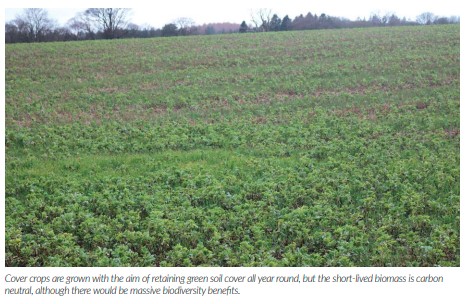
These metrics are accurately calculated by Sandy from records of applications, cross-referenced with meteorological, topographical and other data the software draws in. It also works out the carbon cost, broken down into CO₂ and N₂O. The leaching losses and NUE indicate the financial effect, as well as nutrient loading, that can run into £10,000s for large arable units, advises Alasdair. “The single most effective step you can take is to apply what the plant needs when it needs it – a little and often approach is best. Your foliar application has the potential to help significantly here if it reduces the overall amount applied for the same yield.”
This is where manure can also have a profound effect, he continues. “Organic additions contribute significantly by reducing synthetic fertiliser use, as long as yield is maintained. What’s more, they build soil organic matter and boost biodiversity, so really are a win-win-win for arable soils.”

Cover crops
David’s keen to know how these are contributing to the various elements of the system. “Surely the cover crops are capturing N so less goes down the drains, and then they’re also sequestering carbon into the soil?” Alasdair agrees to a point. “Cover crops can take up a significant amount of N that would otherwise leach and they capture carbon as they grow, both in the leaf and the roots. This carbon is transient, as it’s then breathed out by grazing livestock, deposited as manure or released as the dying leaves decay. This in turn feeds the soil, so can be captured as soil organic carbon which can add to carbon stocks, depending on how you manage your soil.”
Here he points out the ability of Sandy to accurately model a crop’s N and CO₂ capture, drawing in data from management software. “This is where Sandy comes into its own and means you don’t need to take laborious and costly samples, although we’ve now built in the ability to improve accuracy with actual soil analysis data. The added advantage in Sandy is that all data, whether modelled or measured, links through giving results in both the carbon calculator and water module.” The cover crops held through to the summer add little to the farm’s carbon stock, however. “You may have captured more than 2t/ha of CO₂, but short-lived biomass is carbon neutral, in the same way as cash crops, as the carbon captured is released. They will have had a feed value, however, and there would be a massive biodiversity benefit for wild birds and pollinating insects, and that has considerable value in itself.”
Livestock
David is convinced of the benefits of livestock in the rotation, but beef and sheep in particular get a bad rap in carbon calculations. So where does the carbon go? “Grazing with livestock, and particularly managed grazing, works well,” explains Alasdair. “There’s a trade-off because the grazing removes some carbon, but the manure is spread just where you want it in a really usable form that helps the soil sequester carbon long term.
“Carbon is also captured into the roots of the grass or fodder crop – permanent pasture, with grazing well managed, has tremendous sequestration potential, up to 3t/ha CO₂. Forage crops and mob-grazing arable land aren’t quite as good, but poorly managed grazing can actually have quite a poor carbon performance.”

The downside with livestock is the methane (CH₄) they belch and that released from manure, with 1kg of CH₄ equivalent to 28kg of CO₂. “These are also factored in within Sandy and measured according to two standards: GWP100 is the basis used by IPCC, but GWP* is one that is supported by many scientists. GWP* takes a higher initial CO₂ equivalence value for CH₄ but this is reduced over time, which reflects what methane does in the atmosphere. “Cows and sheep emit relatively large amounts of CH₄ over their average lifespan. Grazing outdoors mitigates some of these through the carbon sequestered, and also cuts feed costs, which also have a carbon footprint. But if that means you have to extend the life of the animal for the same liveweight gain, that can actually be less efficient in carbon terms.”
Cultivations
David worries that the carrot enterprise with its intensive cultivations lets down his system that’s otherwise no-till. “The carbon model within Sandy very accurately assesses the carbon balance on a field-by-field basis, informed by the record of your cultivations,” says Alasdair. “Tillage acts as a catalyst for other inputs and keeping the soil in place and undisturbed builds the soil biota, which raises carbon stocks. It varies a lot, but a no-till field could be capturing 500-1000kg/ha CO₂ per year. “Soil carbon stocks take a long time to build and can be destroyed very quickly, but just one year of carrots won’t put levels back to zero and you can still build stocks overall across the rotation.”
Forestry
As well as the commercial forestry, David is planning to put up to 40ha of the arable cropping into agroforestry. He’s keen to explore the carbon potential of the estate’s woodland and hedgerows. Sandy captures and accurately records all types of woodland, including hedgerows and there’s a specific agroforestry module, Alasdair points out. “The forestry is doing the heavy lifting in terms of the estate’s emissions mitigation, and could provide a healthy surplus that can be traded,” he notes. “The woodland blocks will be capturing 3-10t/ha of CO₂. Hedgerows within an arable system are tricky – they have the potential to sequester carbon, but much depends on their management. They have a significant biodiversity value, however.
“Take care with leakage when planting new woodland, or any land use change. Food production displaced from Balbirnie will have to be sourced from elsewhere, which may result in higher emissions per kg of food produced. This would be taken into account if you choose to trade carbon. “But agroforestry presents the best of both worlds – carbon capture in the trees without taking a significant area out of production. It also has great potential to boost biodiversity.”
Renewables
Putting back the biomass boiler is off the cards, but just how much does grain-drying contribute to emissions? Alasdair estimates an upper limit of around 10-20% of arable emissions will be fuel use, and only some of that will go to grain-drying. “So it’s unlikely to knock the farm the wrong side of net zero, but it’s not insignificant. Switching kerosene to biodiesel, if you can source it, will drop the emissions contribution to around 20% of its current level,” he suggests.
The verdict
David feels he’s on the right path, but it’s time to gather the lessons learned and to focus. “We’ve been experimenting with a number of different aspects of regenerative agriculture and we know now what works in a practical sense. It’ll help enormously to put the figures on these and to establish our overall baseline. It takes time though – we’ve been on this journey for seven years and we’re still learning, so there’s plenty of scope to adapt and develop.”
The optimisation tool within Sandy is set to help here. Once David has the baseline data, he can set specific goals he wishes to reach and Sandy will suggest changes to the management practice that’ll help him achieve them. If the business is reducing emissions or sequestering carbon and retaining carbon stock levels, this can be traded through Trinity Natural Capital Markets.
“If we’re sequestering carbon, we should trade that – carbon is cash. But equally that shouldn’t come at a cost to our overall production. The farm output has dipped across the rotation with our move to regenerative agriculture – not massively, but I’d like to bring it back up, sustainably, and that remains the priority,” he concludes.
